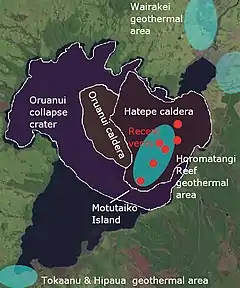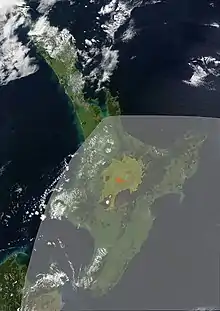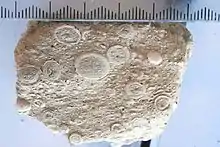Oruanui eruption
The Oruanui eruption of New Zealand's Taupō Volcano (also known as the Kawakawa eruption or Kawakawa/Oruanui event) was the world's most recent supereruption.[1]
| Oruanui eruption | |
|---|---|
| Volcano | Taupō Volcano |
| Date | About 25,700 year BP |
| Type | Ultra-Plinian |
| Location | North Island, New Zealand 38°48′S 175°54′E |
| Volume | 1,170 km3 (280 cu mi) |
| VEI | 8 |
| Impact | Devastated much of North Island with detectable ash fall 5,000 km (3,100 mi) away |
 The Oruanui caldera and collapse crater have been modified by the later smaller Hatepe eruption and other activity in the last 25,000 years. The vents in red have been active more recently. Present active geothermal systems are in light blue. | |
Eruption

With a Volcanic Explosivity Index of 8, it is one of the largest eruptions ever to occur in New Zealand. It occurred about 25675±90 years Before Present[3][4] in the Late Pleistocene and generated approximately 430 km3 (100 cu mi) of pyroclastic fall deposits, 320 km3 (77 cu mi) of pyroclastic density current (PDC) deposits (mostly ignimbrite) and 420 km3 (100 cu mi) of primary intracaldera material, equivalent to 530 km3 (130 cu mi) of magma, totaling 1,170 km3 (280 cu mi) of total deposits. The eruption is divided into 10 different phases on the basis of nine mappable fall units and a tenth, poorly preserved but volumetrically dominant fall unit.[5][2][6][7]
Modern-day Lake Taupō, 616 km2 (238 sq mi) in area and 186 m (610 ft) deep, partly fills the caldera generated during this eruption. A 140 km2 (54 sq mi) structural collapse is concealed beneath Lake Taupō, while the lake outline at least partly reflects volcano-tectonic collapse. Early eruption phases saw shifting vent positions; development of the caldera to its maximum extent (indicated by lithic lag breccias) occurred during phase 10.
Unusual features
The Oruanui eruption shows many unusual features: its episodic nature, a wide range of magma-water interaction, and complex interplay of pyroclastic fall and flow deposits.[5] As the eruption occurred through a lake system (Lake Huka)[2] overlying the vent, many of the deposits contain volcanic ash aggregates.[8]

Local impact
Tephra from the eruption covered much of the central North Island and is termed Kawakawa-Oruanui tephra, or KOT.[9] The Oruanui ignimbrite is up to 200 metres (660 ft) deep. Ashfall affected most of New Zealand, with an ash layer as thick as 18 centimetres (7 in) deposited on the Chatham Islands, 1,000 km (620 mi) away. The local biological impact must have been immense as 10 centimetres (4 in) of ash was deposited from just south of Auckland over the whole of the rest of the North Island and the top of the South Island, both of which were larger in land area as sea levels were considerably lower. The pyroclastic ignimbrite flows certainly destroyed all vegetation they reached.[2] Later erosion and sedimentation had long-lasting effects on the landscape and may have caused the Waikato River to shift from the Hauraki Plains to its current course through the Waikato to the Tasman Sea. Less than 22,500 years ago, Lake Taupō, having filled to about 75 m (246 ft) above its current level and draining initially via a Waihora outlet to the northwest, cut through its Oruanui ignimbrite dam near the present Taupō outlet to the northeast at a rate which left no terraces around the lake. About 60 km3 (14 cu mi) of water was released, leaving boulders of up to 10 m (33 ft) at least as far down the Waikato River as Mangakino.[10] The impact has been summarised as:[2]
- A wholly new landscape around the caldera, with ignimbrite accumulations that were landscape-burying up to hundreds of metres thick and ponding in valleys. The actual area of the ignimbrite is less than the subsequent smaller Hatepe eruption presumably because the later generated a more intense pyroclastic flow but much less accumulative tephra fall.
- The area created by the caldera collapse acted both as a sink for sedimentation in the local catchment and as the basin in which a new Lake Taupō accumulated.
- The former Lake Huka that had extended to the north and partially occupied the older Reporoa Caldera was destroyed and filled in with ignimbrite, which also created a temporary barrier between the Taupō and Reporoa watersheds that had to be eroded before a stable drainage of the new Lake Taupō was established.
- Cumulative thicknesses of fall deposits and ignimbrite were likely sufficient to have wholly destroyed or buried vegetation over virtually all of the central North Island.
- Remobilisation of the vast quantities of pyroclastic material as alluvium produced profound changes in the drainage pattern of the Waikato River, with an impact particularly on the Waikato Plains and Hauraki Plains.
Distal impact
The Oruanui eruption ash deposits from the final (tenth) phase have been geochemically matched to Western Antarctic ice core deposits 5,000 km (3,100 mi) away and they provide a convenient marker for the last glacial maximum in Antarctica.[9] This ash cloud has been modelled to have taken about two weeks to encircle the Southern Hemisphere.[9]
See also
- North Island Volcanic Plateau
- Taupō volcano
- Hatepe eruption (The most recent major eruption of the Taupō volcano, dated to around 232 CE)
References
- Lowe, D. J.; Balks }first2= M. R. (2019). "Introduction to Tephra-Derived Soils and Farming, Waikato-Bay of Plenty, North Island, New Zealand" (PDF).
- Manville, V.; Wilson, C. J. N. (2004). "The 26.5 ka Oruanui eruption, New Zealand: A review of the roles of volcanism and climate in the post‐eruptive sedimentary response". New Zealand Journal of Geology and Geophysics. 47 (3): 525. doi:10.1080/00288306.2004.9515074.
- Dong, Xiyu; Kathayat, Gayatri; Rasmussen, Sune O.; Svensson, Anders; Severinghaus, Jeffrey P.; Li, Hanying; Sinha, Ashish; Xu, Yao; Zhang, Haiwei; Shi, Zhengguo; Cai, Yanjun; Pérez-Mejías, Carlos; Baker, Jonathan; Zhao, Jingyao; Spötl, Christoph (2022-10-04). "Coupled atmosphere-ice-ocean dynamics during Heinrich Stadial 2". Nature Communications. 13 (1): 5867. doi:10.1038/s41467-022-33583-4. ISSN 2041-1723. PMC 9532435. PMID 36195764.
- Muscheler, Raimund; Adolphi, Florian; Heaton, Timothy J; Bronk Ramsey, Christopher; Svensson, Anders; van der Plicht, Johannes; Reimer, Paula J (2020). "Testing and Improving the IntCal20 Calibration Curve with Independent Records". Radiocarbon. 62 (4): 1079–1094. doi:10.1017/RDC.2020.54. ISSN 0033-8222.
- Wilson, C. J. N. (2001). "The 26.5ka Oruanui eruption, New Zealand: An introduction and overview". Journal of Volcanology and Geothermal Research. 112 (1–4): 133–174. Bibcode:2001JVGR..112..133W. doi:10.1016/S0377-0273(01)00239-6.
- Wilson, C. J. N. (2005). "The 26.5 ka Oruanui Eruption, Taupo Volcano, New Zealand: Development, Characteristics and Evacuation of a Large Rhyolitic Magma Body". Journal of Petrology. 47: 35–69. doi:10.1093/petrology/egi066.
- Richard Smith, David J. Lowe and Ian Wright. 'Volcanoes – Lake Taupo', Te Ara – the Encyclopedia of New Zealand, updated 16 April 2007.
- Van Eaton, Alexa R.; Wilson, Colin J. N. (2013). "The nature, origins and distribution of ash aggregates in a large-scale wet eruption deposit: Oruanui, New Zealand". Journal of Volcanology and Geothermal Research. 250: 129–154. Bibcode:2013JVGR..250..129V. doi:10.1016/j.jvolgeores.2012.10.016.
- Dunbar, N.W.; Iverson, N.A.; Van Eaton, A.R.; Sigl, M.; Alloway, B.V.; Kurbatov, A.V.; Mastin, L.G.; McConnell, J.R.; Wilson, C.J.N. (2017). "New Zealand supereruption provides time marker for the Last Glacial Maximum in Antarctica". Scientific Reports. 7 (12238): 12238. Bibcode:2017NatSR...712238D. doi:10.1038/s41598-017-11758-0. PMC 5613013. PMID 28947829.
- Manville, V.; Hodgson, K. A.; Nairn, I. A. (June 2007). "A review of break‐out floods from volcanogenic lakes in New Zealand". New Zealand Journal of Geology and Geophysics. 50 (2): 131–150. doi:10.1080/00288300709509826. ISSN 0028-8306. S2CID 129792354.